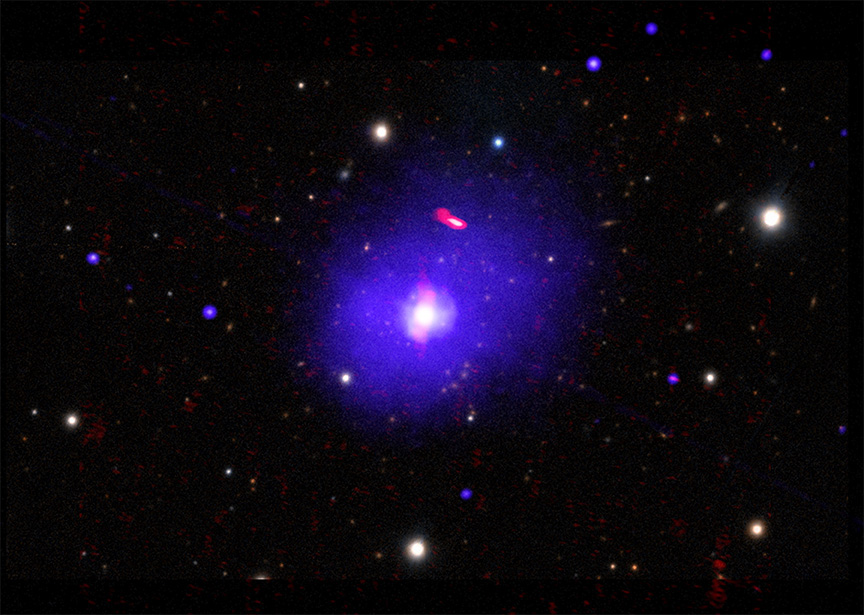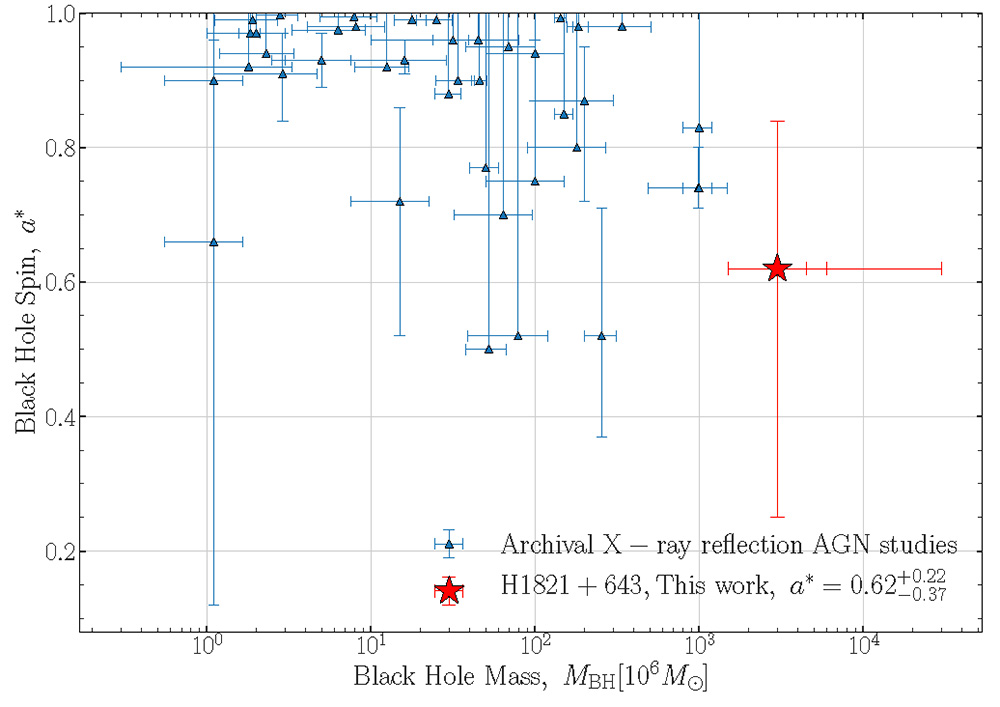X-ray observations add to growing evidence that the most massive black holes have a different past than their lightweight peers.

X-ray: NASA / CXC / Univ. of Cambridge / J. Sisk-Reynés et al.; Radio: NSF / NRAO / VLA; Optical: PanSTARRS
Astronomers have measured the spin of one of the most massive black holes in the modern universe. The results support the idea that such black holes have grown in a different way than their smaller siblings.
Spin is one of two parameters that describe a black hole (the other is mass), and it contains key information about a black hole’s past. For example, gravitational-wave detections show that black holes made by the merger of two smaller ones spin at about 70% of their maximum rate, while those made straight from stars spin much more slowly. (Read our Q&A to find out what spin percentages mean.)
But supermassive black holes are more complicated than the star-size prey hunted by LIGO and its cohorts. These leviathans must have eaten a lot, over an extended period of time, to grow to their current sizes.
Previous studies have found that objects of millions or tens of millions of solar masses usually spin nearly as fast as possible (at least 90% of maximum). That’s expected if the black hole regularly slurps down its meal from a long-lasting, surrounding disk. Even heftier black holes, however, tend to spin more slowly and at a wider range of speeds, suggesting a more varied history.
Júlia Sisk-Reynés (University of Cambridge, UK) and others have now added more evidence to this split history for supermassive black holes. Using archival X-ray observations collected 21 years ago with the Chandra X-ray Observatory, the astronomers measured light reflected off the inner edge of the big tutu of gas skirting the black hole that powers the quasar H1821+643. The quasar lies in a galaxy cluster more than 3 billion light-years away, and with a mass somewhere between 3 and 30 billion Suns (estimates vary), its central black hole is one of the most massive black holes we know of.
The reflected X-rays enabled the researchers to measure the width of the gap between the gas disk’s inner edge and the black hole. A spinning black hole drags its disk in tight around itself, and how close the disk comes to the event horizon reveals how fast the black hole whirls. The X-ray data suggest that H1821+643’s black hole spins anywhere from 25% to 84% of its maximum, with a most likely value of 62%.
The important thing to note here is not the specific value of 62%, but that this spin is a whole lot slower than the rapid twirls of black holes one-thousandth as massive.

J. Sisk-Reynés et al. / Monthly Notices of the Royal Astronomical Society 2022
One explanation for the discrepancy is that the beefiest black holes have a more complicated history than their smaller brethren. Gas coming off a long-lasting disk would always come at the black hole from the same direction, spinning the black hole up like a beach ball hit glancingly by water from a hose. H1821+643’s black hole clearly has a gas disk, but given its spin, the black hole can’t have been eating from this same disk for millions of years.
The suspicion is that objects as hefty as this one instead have “episodic” disks, formed from a big gas cloud that came barreling in on a random trajectory, explains coauthor James Matthews (University of Cambridge, UK). This disk would persist for maybe a few hundred thousand years, feeding the leviathan and influencing its spin. But the next disk to form might have a completely different orientation, putting its own mark on the black hole’s spin. Add to this haphazard history one or more mergers with other big black holes, and the final object could be spinning any number of ways.
There’s a larger environmental effect in all this, too: The biggest black holes tend to reside in the biggest galaxies. Simulations of galaxy and black hole evolution indicate a less orderly flow of material in these galaxies, perhaps explaining why the leviathans’ accretion is more willy-nilly.
Reference
J. Sisk-Reynés et al. “Evidence for a Moderate Spin from X-ray Reflection of the High-mass Supermassive Black Hole in the Cluster-hosted Quasar H1821+643.” Monthly Notices of the Royal Astronomical Society. August 2022.
 1
1









Comments
RC Silk
July 15, 2022 at 5:49 pm
Every black hole is a "seed" of another universe, just as our universe is the "flower" of such a seed.
You must be logged in to post a comment.
You must be logged in to post a comment.